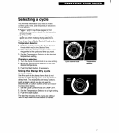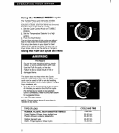
Solving laundering problems
Most laundering problems are easily solved. Check the following list for problems you may have
and possible causes. If you need additional help, check the “If You Need Assistance or Service”
section of this book.
Lint
I
CHECK IF
Dryer fabric softeners
were used
Undiluted washer fabric
softener was used
Enough detergent was used
Items were clean before they
were dried
Lint screen is full
Load is properly sorted
Static electricity is
attracting lint
Load is too big or heavy
Paper or tissue was in pocket
Enough detergent was used
Pilling is being mistaken for lint
CAUSES/SOLUTIONS
Follow manufacturer’s product directions
carefully.
Dilute fabric softener before adding to
the final rinse.
Use enough detergent to hold soil in the
wash water until it drains away. Undrained
soil can stick to outer tub of the washer and
cause greasy spots with next load.
Soiled items can stain other items in the
load. They can also leave stains on the
dryer drum that can be picked up by items
in later loads. Dryer heat may permanently
set these stains.
Clean lint screen. (See page 10.)
Sort lint-givers (bath towels, etc.) from lint-
takers (synthetics, permanent press).
Use fabric softener in the washer’s final
rinse. Use correct dryer settings for fabric.
Overdrying synthetics can cause lint-
attracting static electricity.
Dry smaller loads. When items can’t tumble
freely, air is unable to carry lint to lint
screen.
Empty pockets carefully. A small scrap of
paper can cause a lot of lint.
Use enough detergent to hold the lint in the
water until it drains away. Base detergent
amount on water hardness and soil in wash
load.
Pilling (surface fuzz) is caused by normal
wear and laundering. Pills do not break
away easily from the fabric and can often
collect lint. Synthetic fabrics are more likely
to pill than others, especially at neckbands,
elbows and knees.
16


















